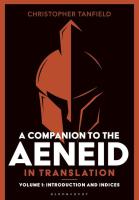
Bloomsbury (2025) p/b vol. I 294pp £19.99 (ISBN 978350499492); vol. II 416pp £22.49 (ISBN 9781350157118); vol. III 472pp £22.49 (ISBN 9781350499546)
Excellent commentaries on Homer in translation have been with us for decades, but this is (to my knowledge) the first time somebody has given readers a comprehensive commentary on the whole of Virgil’s Aeneid in translation. Until now, students—and the general reader—who wish to read the poem in translation have had to glean what help they can from the commentaries on the Latin text. T. bases his commentary on the most widely read modern English translations, by David West (in prose) and Robert Fagles (in verse): each note is headed by the key phrase in both translations. The result is an unqualified success.
Volume 1 gives us a full Introduction, Bibliography and an invaluable 62-page Index, as well as some useful maps and a family tree of the Trojan and Greek families to show who is who and how they are related: volume ii provides the detailed commentary on books 1-6 of the poem, while volume iii handles the last six books.
The Introduction covers the historical, social, literary, philosophical and biographical background to the poem, as well as giving us a summary of the main characters and a good discussion of the role of gods and fate. T. also offers us (pp.139-164) a clear and fascinating account of the long history of the reception of this poem. T. recognises the inherent problems involved in discussing literary and stylistic aspects when we are only reading the poem in translation, but he brings off as much as can with great success: he analyses features such as structure, characterisation, narrative, focalisation, similes and speeches—with even a brave stab at metre. The select bibliography does not contain all the many references to books and articles which are listed in the notes on the commentary—these are all listed where they are needed—but rather is a student’s guide to where to find online resources on the poem and also a judicious selection of books which the reader would find useful in further study.
In the commentary the text is broken up into sections: each one is given a short account (in a shaded box) containing ‘higher-level’ remarks, followed by line-by-line comments on the text as it proceeds. These commentary notes are hugely helpful. For one thing, they refer the reader to the intertextual references linking this poem and its Greek and Roman predecessors (so that for instance in the note on 4.160-72 T. points out how Dido’s ‘marriage’ in the cave is reflecting/refracting the marriage of Jason and Medea in a cave at Apollonius 4.1128-69), and the endnotes to the lemmata then advise the reader where to start looking in the voluminous secondary literature on this most pored-over of poems. Most obviously useful is the way T. helps us keep track of names in this vast poem, such as the many historical figures on the Shield of Aeneas in book 8 or in the Heldenschau in Book 6—T.’s note on (e.g.) the Gracchi and the Scipios at 6.841-6 is a model of how to tell readers everything they need to know within a few well-chosen lines. When Virgil tells us about the battle of Actium, T. gives us a wonderfully helpful diagram of the battle, just as he does with his deft visual depiction of the choreography of the lusus Troiae at 5.560-2, and maps pop up whenever they are needed. In short, this book is going to be of use to anyone reading the poem in either Latin or in English.
To give some idea how this works in practice, take a look at the Nisus and Euryalus episode (Aeneid 9.176-449). T. gives us a full three pages of general introduction to the episode, setting it in its context within the poem and within the epic tradition, showing parallels to the scene, and briefly reporting the different critical reactions it has evoked (with references to the secondary literature in the endnotes). A full page (151) unpacks the links to Homer’s Doloneia (Iliad 10) and points out how Virgil’s account differs from the Homeric source with the two young men behaving now like Odysseus and Diomedes, now like Achilles and Patroclus, now like Dolon, now like Telemachus. The commentary which follows explains the names and the action described and also unpacks the arguments of the key speeches. For obvious reasons it does not comment on features of the Latin—the heavy spondees of 9.229, or the clash of ictus and accent at 9.320, for instance—but does point out where one of the translations misses a key reference in the Latin (such as pestem omitted by Fagles at 9.328) and explains the key Latin word furor at 9.342-3. The notes explaining (e.g.) the Lares at 9.259 are both full and economical, and (where possible) T. cross-refers to discussion elsewhere to avoid repetition of factual information. T. is careful not to spoon-feed the reader with his own literary interpretations, but he always tells us what the Roman reader would have known about the names and the topography in (for instance) the catalogue of troops in Book 7, and also shows us where and how (and sometimes why) Virgil differs from his literary intertextual influences.
This 3-volume set gives us a whopping 1191 pages for a measly £64.97 and is excellent value for money. It is a credit to its author and its publishers for being superbly produced in hyperclear font and refreshingly free of errors. At every point T. puts himself in the shoes of the student reader and has the good teacher’s knack of knowing what to explain and what to leave us to work out for ourselves. His scholarship is impeccable and inspiring, demonstrating on every page a secure grasp of the ancient texts (in Greek and Latin) behind the Aeneid and also the myriad ways to approach this text which is at once both universally known and yet perennially enigmatic.
John Godwin
